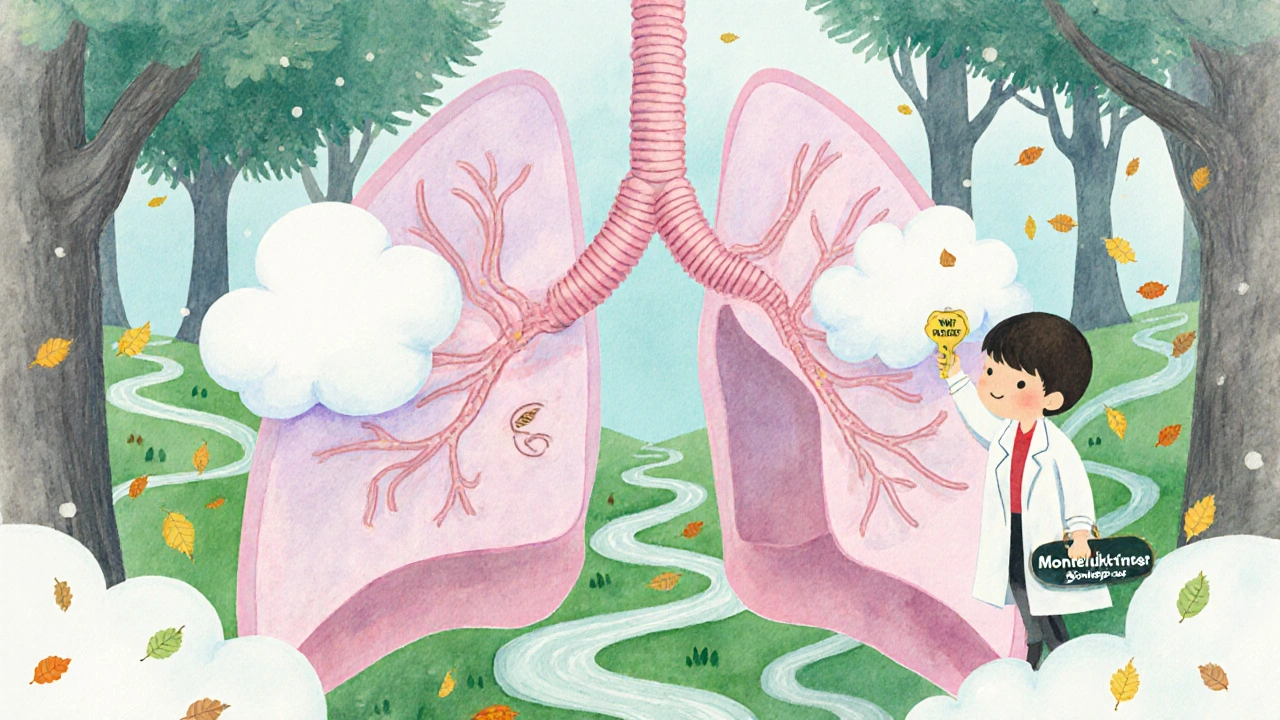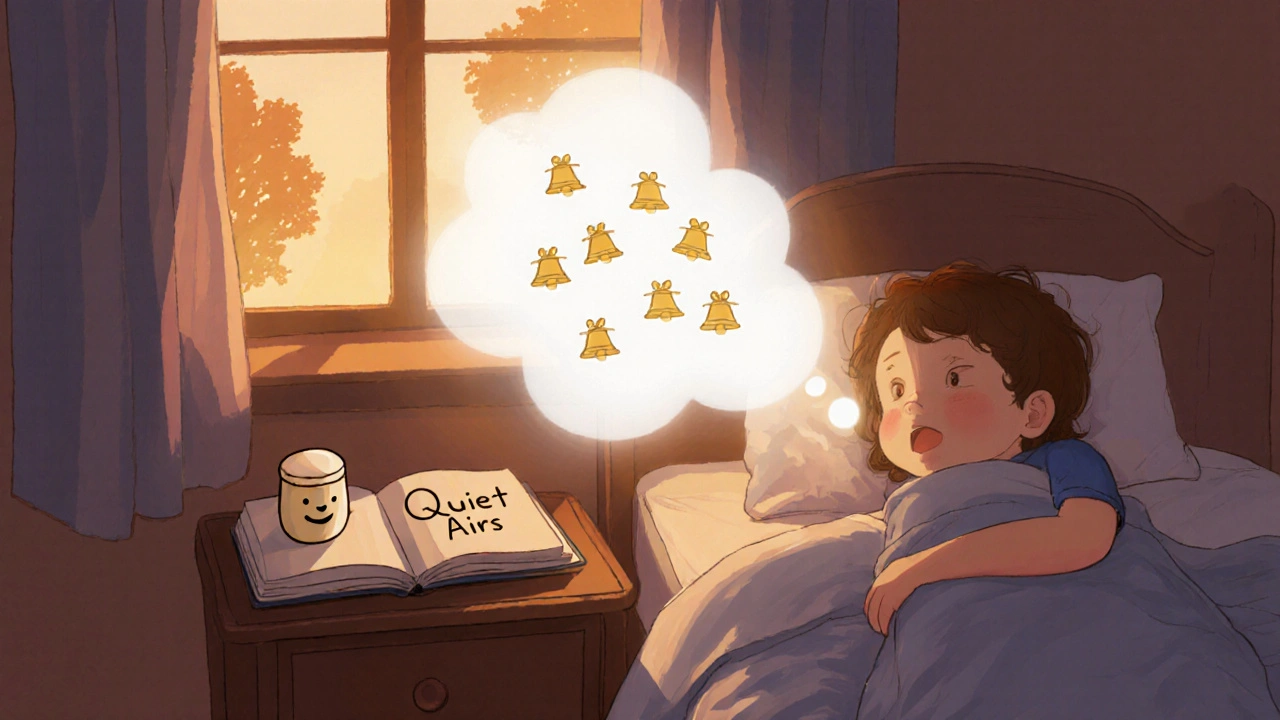When your nose runs, your chest tightens, or you wake up gasping at night from asthma symptoms, you’re not just dealing with allergies - you’re fighting inflammation driven by chemicals your body doesn’t need. One of those chemicals is leukotriene, and blocking it is exactly what montelukast does. Sold under the brand name Singulair and many generics, montelukast isn’t a quick fix like an antihistamine or a rescue inhaler. But for millions of people - especially kids and those who struggle with inhalers - it’s a steady, daily tool that quietly takes the edge off allergic airway disease.
What Exactly Are Leukotrienes and Why Do They Matter?
Leukotrienes aren’t foreign invaders. They’re made inside your own body - from fat molecules called arachidonic acid - when your immune system thinks it’s under attack by pollen, dust, or pet dander. Think of them as alarm signals. When released, they cause three big problems in your airways: your bronchial tubes tighten up, your nasal passages swell, and mucus builds up like a clog in a pipe.
These effects are especially bad in people with asthma or allergic rhinitis. In asthma, leukotrienes trigger nighttime coughing, wheezing, and shortness of breath. In allergic rhinitis, they cause nasal congestion, post-nasal drip, and that constant feeling of being stuffed up. Unlike histamine (which antihistamines target), leukotrienes stick around longer and cause deeper, more persistent inflammation. That’s why some people still feel bad even after taking Zyrtec or Claritin.
How Montelukast Blocks the Alarm
Montelukast works by sitting right on the receptor - the lock - that leukotrienes need to turn on. Specifically, it blocks the CysLT1 receptor, which is the main door through which leukotrienes like LTD4 and LTE4 cause damage. It doesn’t stop your body from making these chemicals. It just says, “Nope, you can’t use them here.”
What’s impressive is how specific it is. Unlike older drugs that hit multiple targets and cause side effects, montelukast doesn’t interfere with beta receptors (used by asthma inhalers), cholinergic pathways (involved in digestion), or prostanoids (linked to pain). That’s why it doesn’t cause dry mouth, rapid heartbeat, or stomach upset the way some other asthma meds do.
Studies show that even a 5mg dose can block up to 75% of the bronchoconstriction caused by allergens. In kids with asthma, it reduces the need for rescue inhalers by nearly half. In adults with seasonal allergies, it cuts nasal symptom scores by about 30-50%, though not as much as a good nasal spray or antihistamine.
Who Gets Prescribed Montelukast - and Who Doesn’t?
Montelukast isn’t first-line for most cases. Here’s where it actually fits:
- Children under 5 who can’t use inhalers properly - doctors often try montelukast before forcing a daily steroid inhaler on a toddler.
- People with both asthma and allergic rhinitis - since montelukast helps both upper and lower airways, it’s one pill for two problems.
- Those who can’t tolerate inhaled corticosteroids - maybe they hate the throat irritation, or they forget to rinse after use, or their insurance won’t cover it.
- Patients with exercise-induced asthma - though not as fast as albuterol, it can reduce symptoms over time if taken daily.
But here’s where it falls short:
- Not for acute attacks - if you’re wheezing right now, montelukast won’t help. It takes days to build up. Keep your rescue inhaler handy.
- Inferior to inhaled steroids - for persistent asthma, fluticasone or budesonide work better. Montelukast is the backup plan.
- Less effective than antihistamines for rhinitis - if your main issue is sneezing and runny nose, Zyrtec or Claritin will beat it.
According to the Global Initiative for Asthma (GINA), montelukast is recommended only as an alternative when inhaled steroids aren’t possible - not as a replacement.

Real People, Real Results
On Reddit, a 32-year-old mom wrote: “I started montelukast after my daughter’s asthma flared every night. Within a week, she stopped waking up coughing. We still use her inhaler for exercise, but now she only needs it once a week instead of daily.”
Another user on Drugs.com said: “It helped my allergies - about half. But my nose was still stuffed. Zyrtec cleared that up in an hour.”
And a father on WebMD shared: “My son hated his inhaler. He’d spit it out. We switched to montelukast granules mixed in applesauce. His lung function improved. No more missed school.”
These stories aren’t outliers. Around 28% of pediatric asthma patients in the U.S. get montelukast as a controller, mostly because it’s easier to give than an inhaler. For adults, it’s less common - only 12% of allergic rhinitis prescriptions are for montelukast, compared to 38% for antihistamines.
Side Effects and Warnings You Can’t Ignore
Most people tolerate montelukast fine. Common complaints? Headache, stomach ache, cough - mild stuff.
But there’s a red flag the FDA added in 2020: neuropsychiatric side effects. That means things like:
- Agitation or irritability
- Depression or mood swings
- Sleep disturbances - nightmares, insomnia
- Rarely, thoughts of self-harm
These aren’t common - maybe 1 in 1,000 users - but they’re serious. Parents of young children on montelukast should watch for sudden changes in behavior. Adults should note if they feel unusually down or anxious after starting the drug. If it happens, stop and call your doctor. Don’t just tough it out.
Other rare risks include eosinophilia (too many white blood cells) and allergic reactions like rash or swelling. But these are extremely uncommon.

Dosing, Timing, and How to Take It Right
Montelukast comes in three forms: 10mg tablets for adults, 5mg and 4mg chewables for kids, and 4mg granules that you can mix with soft food like applesauce or yogurt. You take it once a day, usually at night.
Why night? Because leukotriene levels peak in the early morning - which is why asthma symptoms are worst at dawn. Taking it at bedtime helps block that surge.
Don’t expect instant results. It takes 24-48 hours to start working. Full effect? About a week. That’s why people get frustrated - they think it’s not working after two days. It’s not a fast-acting drug. It’s a slow, steady one.
And never use it to treat an asthma attack. If you’re having trouble breathing, use your albuterol inhaler. Montelukast won’t help - and waiting for it to work could be dangerous.
How It Compares to Other Options
Here’s how montelukast stacks up against common alternatives:
| Treatment | Best For | Speed of Action | Side Effects | Adherence |
|---|---|---|---|---|
| Montelukast | Chronic asthma + allergic rhinitis, kids, inhaler-intolerant | Days to weeks | Mild: headache, stomach ache; rare: mood changes | High - once daily, no technique needed |
| Inhaled Corticosteroids (ICS) | Persistent asthma (first-line) | Weeks | Throat irritation, oral thrush | Low to moderate - requires proper technique |
| Second-Gen Antihistamines (Zyrtec, Claritin) | Runny nose, sneezing, itchy eyes | Hours | Drowsiness (less than old ones), dry mouth | High - once daily |
| Rescue Inhalers (Albuterol) | Asthma attacks, exercise triggers | Minutes | Tremor, fast heartbeat | Low - only used as needed |
| Nasal Corticosteroids (Flonase) | Nasal congestion, post-nasal drip | Days to weeks | Nosebleeds, dryness | Moderate - daily use required |
Montelukast’s biggest advantage? It’s simple. No puffing, no rinsing, no messy sprays. Just one pill. That’s why it’s still prescribed over 14 million times a year in the U.S., even though generics cost as little as $4 a month.
What’s Next for Montelukast?
Biologic drugs - like omalizumab or mepolizumab - are changing asthma care. These injectables target specific immune cells and work wonders for severe cases. But they cost thousands per year. Montelukast? It’s cheap, easy, and safe for long-term use.
For now, it holds its ground as the go-to option when other treatments aren’t working - or aren’t possible. The American Academy of Pediatrics still lists it as a valid alternative for kids with mild asthma who can’t use inhalers. The European Respiratory Society says it’s fine for mild persistent asthma, as long as you’re not skipping steroids when they’re needed.
It’s not glamorous. It’s not the newest thing. But for many families, it’s the quiet hero that keeps kids in school and adults breathing through allergy season.
Can montelukast be used for sudden asthma attacks?
No. Montelukast is not a rescue medication. It works over days to reduce inflammation but won’t open your airways during an attack. Always use a short-acting beta-agonist inhaler like albuterol for immediate relief. Relying on montelukast during an asthma flare could be dangerous.
Is montelukast safe for children?
Yes, montelukast is approved for children as young as 12 months for asthma and 2 years for allergic rhinitis. The granule form makes it easy to give to toddlers. However, parents should watch for behavioral changes like irritability, sleep problems, or mood swings - rare but serious side effects flagged by the FDA in 2020. If you notice sudden changes in behavior, contact your doctor.
How long does it take for montelukast to start working?
Some people notice improvement in symptoms within 24 to 48 hours, especially in nighttime asthma or allergy symptoms. But full benefits - like reduced use of rescue inhalers or better lung function - typically take up to one week. Don’t stop taking it if you don’t feel better right away. It’s designed for daily, long-term control, not instant relief.
Can I take montelukast with antihistamines or inhalers?
Yes, montelukast is often used alongside antihistamines (like Zyrtec) and inhaled corticosteroids (like fluticasone). In fact, many patients benefit from combining treatments - antihistamines for sneezing and runny nose, montelukast for chest tightness and inflammation, and inhalers for asthma control. Always check with your doctor before combining medications, but it’s a common and effective strategy.
Why is montelukast still prescribed if it’s not first-line?
Because it fills a real gap. Many patients - especially young children - can’t use inhalers properly. Others can’t tolerate steroid side effects. Montelukast offers a safe, oral alternative that works for both asthma and allergic rhinitis. Even if it’s less powerful than inhaled steroids, it’s far better than nothing. Its low cost, simple dosing, and broad safety profile keep it in use for millions of people worldwide.


seamus moginie
November 19, 2025 AT 19:58Montelukast is a miracle drug for children who can't handle inhalers - period. I've seen it turn chaotic nights into peaceful sleep. The FDA warnings? Yes, they exist. But so do the 999 out of 1000 kids who take it without a single behavioral hiccup. Don't let fear override function.
Christopher K
November 20, 2025 AT 13:07Oh great, another pill-pushing placebo dressed up as science. In America, we don't treat asthma - we medicate it into submission while ignoring clean air, allergen reduction, or basic hygiene. This drug's popularity? Blame lazy doctors and corporate marketing. Let the kids breathe fresh air instead of swallowing synthetic blocks.
river weiss
November 20, 2025 AT 16:50While I appreciate the detailed breakdown, I must emphasize: montelukast’s role is not to replace inhaled corticosteroids, but to complement them when adherence is an issue. The granule formulation is a game-changer for toddlers; mixing it with applesauce removes the entire barrier of technique. It’s not glamorous, but it’s functional - and in pediatric care, function wins over flair every time.
Ellen Calnan
November 21, 2025 AT 16:21There’s something quietly heroic about a drug that doesn’t scream for attention - no puffing, no spraying, no dramatic inhalers. Just one pill at night, quietly holding back the storm inside the lungs. It’s the unsung hero of allergic airway disease. And yet, we treat it like a second-tier option because it’s not flashy. Maybe we need to rethink what ‘effective’ really means.
Derron Vanderpoel
November 23, 2025 AT 04:33my son took this for 6 months and started having nightmares where he was drowning in pollen. i didn't connect it until i read the fda warning. we stopped it. he slept like a baby again. i'm not scared of meds but i'm scared of silent side effects. this isn't just 'headache and stomach ache' - it's your kid screaming in the dark and you don't know why.
Brian Rono
November 24, 2025 AT 09:26Let’s be brutally honest: montelukast is the pharmaceutical equivalent of a Band-Aid on a ruptured aneurysm. It’s not that it doesn’t work - it’s that it works *too well* at pretending to fix the problem while the real issue - environmental triggers, indoor air quality, chronic inflammation from processed foods - is left untouched. We’re optimizing the symptom, not the system. And that’s a tragedy disguised as progress.
Also, calling it a ‘quiet hero’ is poetic nonsense. It’s a chemically selective receptor blocker with a black box warning for psychosis. Let’s stop romanticizing pharmacological convenience and start demanding systemic solutions.
And for the love of all that’s holy, if your kid is on this and suddenly starts crying uncontrollably at 3 a.m., don’t Google it - call your pediatrician. Not Reddit. Not WebMD. Your doctor.
Richard Risemberg
November 24, 2025 AT 23:30For parents reading this: if your child can’t use an inhaler, montelukast isn’t a compromise - it’s a lifeline. I’ve seen kids go from missing school weekly to acing soccer tryouts because they finally had consistent control. Yes, the mood side effects are real - but so is the terror of watching your child gasp for air at 2 a.m. You weigh the risks, you monitor closely, and you don’t abandon a tool that gives your child back their childhood.
Also, the comparison table? Spot on. Adherence is king. A drug that works 70% as well but gets taken 95% of the time? That’s the real win.
Dana Dolan
November 25, 2025 AT 19:49i just want to say thank you for writing this. my daughter’s allergist prescribed this after she couldn't stop coughing at night. we tried everything - nebulizers, nasal sprays, even allergy shots - and nothing stuck. montelukast was the first thing that made her sleep through the night. i know about the mood stuff, and we watch her like a hawk. but honestly? i'd rather have a kid who's a little moody than one who can't breathe. this post got me crying a little. thank you.
Dion Hetemi
November 26, 2025 AT 05:08So let me get this straight - we’re praising a drug that has a documented risk of suicidal ideation in children, but we’re calling it ‘safe’ because it’s cheap? That’s not a win. That’s corporate negligence dressed in pediatrician scrubs. The fact that 28% of kids are on this? That’s a national failure in asthma management. We’re not fixing the problem - we’re just making it less inconvenient for adults to ignore it.
Kara Binning
November 26, 2025 AT 09:44Okay, but can we talk about how the medical establishment treats montelukast like it’s the awkward cousin at Thanksgiving? ‘Oh, we’ll give it to the toddler because they can’t use the inhaler… but don’t you dare use it as first-line.’ So it’s okay to risk psychosis in a 2-year-old, but not okay to use it properly? This isn’t medicine - it’s a bureaucratic compromise wrapped in a pill. I’m done pretending this is ethical.
Zac Gray
November 27, 2025 AT 19:07Look - I get the fear around psychiatric side effects. I’ve had patients cry in my office over nightmares after starting montelukast. But I’ve also had parents say, ‘I didn’t know my kid was wheezing until he stopped doing it.’ This isn’t about being pro-drug or anti-drug. It’s about being pro-child. If a child can’t use an inhaler, and their asthma is uncontrolled, and their quality of life is tanking - then yes, montelukast is a reasonable, monitored, temporary bridge. Not a forever fix. Not a magic bullet. But a bridge. And bridges aren’t glamorous - they’re necessary.
And for the record: the 1 in 1,000 risk of mood changes? That’s higher than the risk of dying from a car ride to the ER during an asthma attack. Context matters.
Joe Durham
November 29, 2025 AT 00:57Just wanted to add something real: my wife’s asthma got worse after we moved to a city with high ozone. We tried everything. Montelukast didn’t fix her allergies - but it stopped the nightly panic attacks from chest tightness. She still uses her inhaler. She still avoids triggers. But now, she sleeps. And that’s not nothing. I’m not here to defend Big Pharma. I’m here to say: if this drug gives someone their night back, it’s worth the watchful waiting.